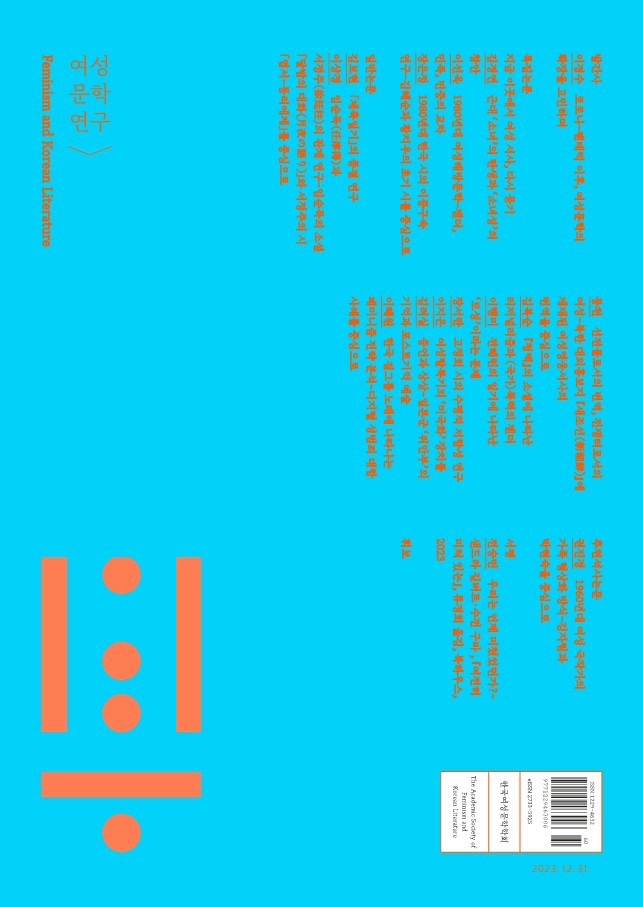- KOREAN
- P-ISSN1229-4632
- E-ISSN2733-5925
- KCI
 ISSN : 1229-4632
ISSN : 1229-4632
Recollections of and Compositions about Non-Identical Female Subjects : An Analysis of Jung Sae-rang’s From the Si-sun
Abstract
This article interprets the process of female subject formation in Jung Sae-rang ’s latest novel From the Si-sun while also exploring the restoration of sirens in women’s mythology. Through “commingling,” Si-sun forms relationships with other female subjects, and while expanding these relations, she rewrites history using her own voice, similar to the “non-identical egos” of sirens. The “non-uniform” ego, which is not encompassed by the mechanism of modern homogenization, does not stop at Si-sun; rather, it extends from Sisun to others of the same age and women of later generations. This is achieved by making heard the voices of a women that have long been marginalized; that is, it is achieved via an act of writing that is comparable to the act of speaking. The act of rewriting personal memories causes ruptures in the identity of history by “reflecting”(Eingedenken) on a hidden history that has not appeared as part of official history. Si-sun’s descendnants repeatedly reenact her past like a festival in the form of a “ceremony.” However, this act is also a way of criticizing modernity’s violence by granting new meaning to the history of other people’s bodies and languages.
- keywords
- women’s mythology, From the Si-sun, novelist Jung Sae-rang, non-identical female subject, reflecting and writing, 여성 신화, 『시선으로부터, 』, 정세랑 소설, 비동일적 여성 주체, 회상과 글쓰기
Reference
정세랑, 『시선으로부터,』, 문학동네, 2020.
김애령, 『듣기의 윤리』, 봄날의박씨, 2020, 79-85쪽.
노성숙, 「주체 속에 있는 자연의 회상」, 『예술과 현상학』, 철학과현실사, 2001, 322-323쪽.
노성숙, 『사이렌의 침묵과 노래』, 여이연, 2008, 75-77, 101-113, 140-144쪽.
윤택림, 『구술사 연구방법론』, 아르케, 2019, 105, 123-128쪽.
윤택림, 『구술사, 기억으로 쓰는 역사』, 아르케, 2010, 17쪽.
나탕 바슈텔, 윤택림 역, 「기억과 역사 사이에서」, 위의 책, 116쪽.
레나타 살레클, 이성민 역, 『사랑과 증오의 도착들』, 도서출판b, 2003, 103쪽.
아도르노·호르크하이머, 김유동 역, 『계몽의 변증법』, 문학과지성사, 2020, 31, 81-99, 105, 280-284, 343쪽.
조르주 디디 위베르만, 김홍기 역, 『반딧불의 잔존』, 도서출판 길, 2020, 71, 126-133쪽.
조애나 러스, 나현영 역, 『SF는 어떻게 여자들의 놀이터가 되었나』, 포도밭출판사, 2020, 171-172쪽.
테오도르 아도르노, 이순예 역, 『부정변증법 강의』, 세창출판사, 2012, 16-17,57, 64-65쪽.
프란츠 카프카, 편영수·임홍배 역, 「세이렌의 침묵」, 『변신·단식 광대』, 창비, 2020, 199-201쪽.
호메로스, 천병희 역, 『오뒷세이아』, 도서출판 숲, 2015, 303쪽.
김양선, 「팬데믹 이후 사회에 대한 (여성)문학의 응답」, 『비교한국학』 제29권 1호, 비교한국학회, 2021, 15-33쪽.
노성숙, 「외상에 대한 ‘기억’의 철학상담적 치유 가능성 모색」, 『가톨릭철학』 제29호, 한국가톨릭철학회, 2017, 201-240쪽.
오은교, 「정세랑의 많은 사람들」, 〈문장웹진〉, 2018.12.01., https://webzine.munjang.or.kr/archives/143201, 접속일: 2021.12.09.
윤택림, 「개인적 서술에서 공공의 기억으로:구술사와 공공역사」, 『구술사연구』 제11권 1호, 한국구술사학회, 2020, 9-45쪽.
이진송, 「어서오세요, 정세랑의 언저리 월드에!」, 『문학동네』 제27권 4호, 문학동네, 2020, 23-44쪽.
인아영, 「여성 청년들의 민족지 혹은 생존기」, 『문학과사회』 제32권 1호, 문학과지성사, 2019, 278-288쪽.
정현철, 「미와 변증법: 아도르노의 미학적인 이론에 있어서의 부정성 개념」, 『헤겔연구』 제19권, 한국헤겔학회, 2006, 183-217쪽.
- Downloaded
- Viewed
- 0KCI Citations
- 0WOS Citations
